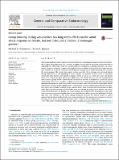Files in this item
Group housing during adolescence has long-term effects on the adult stress response in female, but not male, zebra finches (Taeniopygia guttata)
Item metadata
| dc.contributor.author | Emmerson, Michael G. | |
| dc.contributor.author | Spencer, Karen A. | |
| dc.date.accessioned | 2017-10-20T15:30:22Z | |
| dc.date.available | 2017-10-20T15:30:22Z | |
| dc.date.issued | 2018-01-15 | |
| dc.identifier | 250467447 | |
| dc.identifier | 0e655400-ddfa-4b11-b93b-707777591260 | |
| dc.identifier | 85025125640 | |
| dc.identifier | 000423013200012 | |
| dc.identifier.citation | Emmerson , M G & Spencer , K A 2018 , ' Group housing during adolescence has long-term effects on the adult stress response in female, but not male, zebra finches ( Taeniopygia guttata ) ' , General and Comparative Endocrinology , vol. 256 , pp. 71-79 . https://doi.org/10.1016/j.ygcen.2017.07.008 | en |
| dc.identifier.issn | 0016-6480 | |
| dc.identifier.other | RIS: urn:F2C83C64E16244DB2A35CCE6886349F2 | |
| dc.identifier.other | ORCID: /0000-0002-2851-9379/work/78204992 | |
| dc.identifier.uri | https://hdl.handle.net/10023/11894 | |
| dc.description | Funding was provided by a BBSRC David Phillips Research Fellowship to KAS and a University of St Andrews postgraduate scholarship to MGE. | en |
| dc.description.abstract | Adolescent social interactions can have long-term effects on physiological responses to stressors in later-life. A larger adolescent group size can result in higher stressor-induced secretion of glucocorticoids in adulthood. The effect may be due to a socially-mediated modulation of gonadal hormones, e.g. testosterone. However, group size (number of animals) has been conflated with social density (space per animal). Therefore it is hard to determine the mechanisms through which adolescent group size can affect the stress response. The current study aimed to tease apart the effects of group size and social density during adolescence on the physiological stress response and gonadal hormone levels in adulthood. Adolescent zebra finches were housed in groups varying in size (2 vs. 5 birds per cage) and density (0.03m3 vs. 0.06m3 per bird) during early adolescence (day 40-60). Density was only manipulated in birds raised in groups of five. Glucocorticoid concentration secreted in response to a standard capture and restraint stressor was quantified in adolescence (day 55±1) and adulthood (day 100+). Basal gonadal hormones concentrations (male testosterone, female estradiol) were also quantified in adulthood. Female birds housed in larger groups, independent of social density, secreted a higher glucocorticoid concentration 45 mins into restraint regardless of age, and had higher peak glucocorticoid concentration in adulthood. Adult gonadal hormone concentrations were not affected by group size or density. Our results suggest that group size, not density, is a social condition that influences the development of the endocrine response to stressors in female zebra finches, and that these effects persist into adulthood. The findings have clear relevance to the social housing conditions necessary for optimal welfare in captive animals, but also elucidate the role of social rearing conditions in the emergence of responses to stressors that may persist across the lifespan and affect fitness of animals in wild populations. | |
| dc.format.extent | 9 | |
| dc.format.extent | 638440 | |
| dc.language.iso | eng | |
| dc.relation.ispartof | General and Comparative Endocrinology | en |
| dc.subject | Adolescence | en |
| dc.subject | Plasticity | en |
| dc.subject | Group size | en |
| dc.subject | Crowding | en |
| dc.subject | Social stress | en |
| dc.subject | Stress response | en |
| dc.subject | BF Psychology | en |
| dc.subject | NDAS | en |
| dc.subject.lcc | BF | en |
| dc.title | Group housing during adolescence has long-term effects on the adult stress response in female, but not male, zebra finches (Taeniopygia guttata) | en |
| dc.type | Journal article | en |
| dc.contributor.sponsor | BBSRC | en |
| dc.contributor.institution | University of St Andrews. School of Psychology and Neuroscience | en |
| dc.identifier.doi | https://doi.org/10.1016/j.ygcen.2017.07.008 | |
| dc.description.status | Peer reviewed | en |
| dc.identifier.grantnumber | en |
This item appears in the following Collection(s)
Items in the St Andrews Research Repository are protected by copyright, with all rights reserved, unless otherwise indicated.

